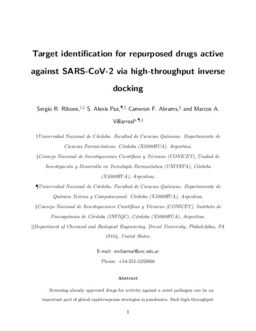| dc.contributor.author | Ribone, Sergio P. | |
| dc.contributor.author | Paz, S. Alexis | |
| dc.contributor.author | Abrams, Cameron F. | |
| dc.contributor.author | Villarreal, Marcos A. | |
| dc.date.accessioned | 2021-09-01T01:22:56Z | |
| dc.date.available | 2021-09-01T01:22:56Z | |
| dc.date.issued | 2021-06-25 | |
| dc.identifier.citation | Ribone SP, Paz SA, Abrams CF, Villarreal MA. Target identification for repurposed drugs active against SARS-CoV-2 via high-throughput inverse docking. ChemRxiv. Cambridge: Cambridge Open Engage; 2021; This content is a preprint and has not been peer-reviewed. | es |
| dc.identifier.uri | http://hdl.handle.net/11086/20029 | |
| dc.identifier.uri | https://chemrxiv.org/engage/chemrxiv/article-details/60d4e352e211334430e0a008 | |
| dc.description.abstract | Screening already approved drugs for activity against a novel pathogen can be an important part of global rapid-response strategies in pandemics. Such high-throughput repurposing screens have already identified several existing drugs with potential to combat SARS-CoV-2. However, moving these hits forward for possible development into drugs specifically against this pathogen requires unambiguous identification of their corresponding targets, something the high-throughput screens are not typically designed to reveal. We present here a new computational inverse-docking protocol that uses all-atom protein structures and a combination of docking methods to rank order targets for each of several existing drugs for which a plurality of recent hight-hroughput screens detected anti-SARS-CoV-2 activity. We demonstrate validation of this method with known drug-target pairs, including both non-antiviral and antiviral compounds. We subjected 152 distinct drugs potentially suitable for repurposing to the inverse docking procedure. The most common preferential targets were the human enzymes TMPRSS2 and PIKfyve, followed by the viral enzymes Helicase and PLpro. All compounds that selected TMPRSS2 are known serine protease inhibitors, and those that selected PIKfyve are known tyrosine kinase inhibitors. Detailed structural analysis of the docking poses revealed important insights into why these selections arose, and could potentially lead to more rational design of new drugs against these targets. | es |
| dc.language.iso | spa | es |
| dc.publisher | Cambridge University Press. ChemRxiv | es |
| dc.rights | Attribution-NonCommercial-NoDerivatives 4.0 Internacional | * |
| dc.rights.uri | http://creativecommons.org/licenses/by-nc-nd/4.0/ | * |
| dc.subject | Covid 19 | es |
| dc.subject | SARS-CoV-2 | es |
| dc.subject | High-throughput | es |
| dc.subject | Inverse docking | es |
| dc.subject | Docking software | es |
| dc.title | Target identification for repurposed drugs active against SARS-CoV-2 via high-throughput inverse docking (version 1) | es |
| dc.type | Preimpreso | es |
| dc.description.fil | Fil: Ribone, Sergio P. Universidad Nacional de Córdoba. Facultad de Ciencias Químicas. Departamento de Ciencias Farmacéuticas; Argentina. | es |
| dc.description.fil | Fil: Ribone, Sergio P. Consejo Nacional de Investigaciones Científicas y Técnicas. Unidad de Investigación y Desarrollo en Tecnología Farmacéutica; Argentina. | es |
| dc.description.fil | Fil: Paz; S. Alexis. Universidad Nacional de Córdoba. Facultad de Ciencias Químicas; Argentina. | es |
| dc.description.fil | Fil: Paz, S. Alexis. Consejo Nacional de Investigaciones Científicas y Técnicas. Instituto de Investigaciones en Físico-química de Córdoba; Argentina. | es |
| dc.description.fil | Fil: Abrams, Cameron F. Drexel University. Department of Chemical and Biological Engineering, Philadelphia; United States. | es |
| dc.description.fil | Fil: Villarreal Marcos A. Universidad Nacional de Córdoba. Facultad de Ciencias Químicas; Argentina. | es |
| dc.description.fil | Fil: Villarreal Marcos A. Consejo Nacional de Investigaciones Científicas y Técnicas. Instituto de Investigaciones en Físico-química de Córdoba; Argentina. | es |
| dc.description.fil | Fil: Paz; S. Alexis. Universidad Nacional de Córdoba. Facultad de Ciencias Químicas; Argentina. | es |





